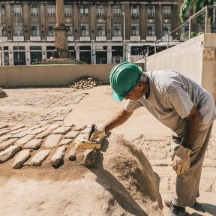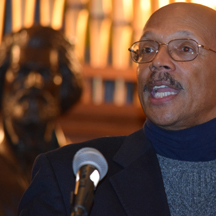The original stone Valongo Wharf stands in central Rio de Janeiro, Brazil and was built in 1811 for the landing of enslaved Africans. An estimated 900,000 Africans arrived in South America at this location (in contrast, an estimated 388,000 Africans arrived in all of North America). The remains of Valongo Wharf are believed to be the most important physical traces of the arrival of African slaves on the American continent.
The distance from Rio to Charleston is 3,937 nautical miles but greed and the telegraph spanned the interval and, in many ways, Brazil was the senior partner in the blood trade. Brazil already had a longer history enslaving its indigenous peoples while the capture, kidnapping, enslavement, and importation of Africans began midway through the 16th century. During the apogee of the Trans-Atlantic Slave Trade, Brazil imported more enslaved Africans than any other country in the world. At least 4.9 million enslaved people from Africa were imported to Brazil between 1501 and 1866.
Later still, the Southern Standard of Charleston suggested that if the Slave South and Brazil sought to act together by treaty "we can preserve domestic servitude and defy the power of the world."
In the early 1800s, Thomas Amory of Charleston, who knew the Guinea coast of West Africa very well, singled out the ease with which he could send slaves to Brazil "for negroes sell as well at South Carolina as at Brazil." Around this same time, southern newspapers recorded sales to and offers for the purchase of American ships by Brazilian slave traders. Later still, the Southern Standard of Charleston suggested that if the Slave South and Brazil sought to act together by treaty "we can preserve domestic servitude and defy the power of the world."
Rio was already a great slave port long before the Valongo Wharf, but as Maria Gravari-Barbas, Nelson Grabura, and Jean-Francois Stazak observed in "Tourism Fictions, Simulacra, and Virtualities" … as early as 1718, plans were made to transfer the port to a less conspicuous locale further down the bay, so that the sight and smell of the human cargo would not offend elite sensibilities.
For
historian Claudio Honorato, it was not the slave trade per se that upset European patricians, but the "repugnant sight" of disheveled, half-naked black bodies, potentially contagious or violent. In 1774, the construction of a new stone dock finally allowed the transfer of port activities to an area known as the Valongo (Val Longo, the long valley), isolated by hills and mangrove, at a safe distance from the city center. The arrival of the Portuguese royal family escaping the Napoleonic wars in 1808 precipitated the slave market's relocation to the Valongo.
Slave ships bound for Rio, Brazil's foremost port, crossed picturesque Guanabara Bay, passed Sugarloaf mountain, and saw the looming palm trees knowing the horror that would begin again at the shore.
"The new purpose built Valongo Wharf would become the focal point of the busiest slave trading complex . . . in the Americas . . . they were fattened, sold, and exchanged in nearby warehouses . . . while the construction of trading centers and depots dynamized the local economy, the transfer of the slave market to Valongo contributed to the consolidation of the port's function as a repository for disreputable activities in the city," added Maria Gravari-Barbas, Nelson Graburn, and Jean Francois Staszak.
The fetid holds of the ships, the chains and shackles took a staggering toll on the lives of the Africans. Near the wharf, some 40,000 were buried in the Cemetery of the New Blacks, where the bones of the dead were frequently crushed to make room for more corpses. After the rise of the abolitionist in Europe in the 1830s, the trade was transferred to smaller, less visible docks down the bay, where it continued to thrive until Brazil finally abolished slavery in 1888, the last nation to do so.
In 1843, to welcome the future wife of the Brazilian emperor, the Valongo wharf was covered by stone slabs and renamed Empress Wharf. Urban renewal efforts further changed the appearance of the wharf and altered its topography. The area was paved over again and transformed into a public square. The neighborhood, had become over time a teeming center of black Brazilians often called "Little Africa."
Although Blacks had been in Rio since at least 1585, and their population would often exceed that of Whites, their identity and history. like that of Valongo Wharf, was being erased in service of a national mythology that alleges that Brazil is a sun-kissed racial paradise of swaying palm trees.
Note:
The International African American Museum sits on the former site of Gadsden Wharf in downtown Charleston. It is expected to open the weekend of January 21, 2023
Part 1 -
From Gadsden's Wharf, USA to Valongo Wharf, Brazil
Part 2 -
From Gadsden's Wharf, USA to Valongo Wharf, Brazil – The Fall of Charleston and The Rise of Freedom
Coming:
Part 4 - In Memory and Healing
Note:
The Underground Railroad in the DMV with C.R. Gibbs
Tue, Dec 20, 4p








